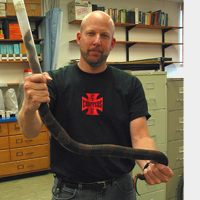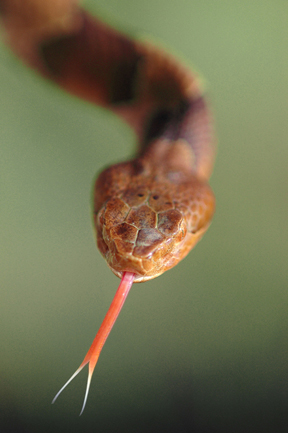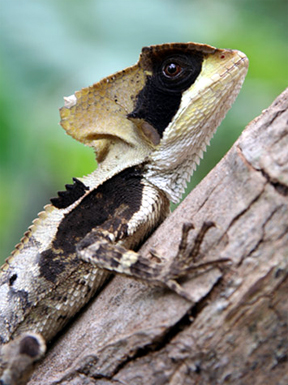Kurt Schwenk
Professor
Contact Information
Office: BioPharmacy 600
Voice: (860) 486-0351
Fax: (860) 486-6364
E-mail: kurt.schwenk@uconn.edu
Home page:
under construction
Mailing address:
Department of Ecology and Evolutionary Biology
University of Connecticut
75 N. Eagleville Road, U-3043
Storrs, CT 06269
Major Research Interests
Phenotypic evolution
Evolutionary constraint
Evolutionary and functional morphology of vertebrates
Evolutionary and functional morphology of feeding in tetrapod vertebrates, especially squamate reptiles (lizards and snakes)
Evolutionary and functional morphology of chemoreception in squamate reptiles
Evolutionary and functional morphology of the vertebrate tongue
My research program is three-pronged: I pursue empirical studies related to the functional and evolutionary morphology of squamate feeding and chemoreception and theoretical work related to phenotypic evolution and evolutionary constraint. Feeding and chemoreception are functionally and evolutionarily related in squamates owing to their shared use of a single, complex organ, the tongue. From a biomechanical point of view, a tongue form optimized for feeding function makes optimization for (vomeronasal) chemosensory function virtually impossible, and vice versa. Thus, there is an evolutioinary 'tension' between the two principal sources of selection pressure on the tongue and phylogenetic analysis reveals how each major clade of squamates has found a unique 'solution' to this evolutionary problem. It is the dynamic nature of this evolutionary tension that has led to my theoretical work on evolutionary constraint. Feeding and chemosensory systems character comlexes that manifest the system-level properties of 'hierarchy', 'functional integration', 'internal selection', 'trade-off' and 'emergence', and it is these attributes that make them amenable to theoretical analysis and generalization.
Information for Potential Graduate Students
Students in my laboratory develop their own, independent research programs under my supervision. Although I expect there to be some overlap or mutual interest in student projects, I do not require students to work in my specific research areas. Ideally students will incorporate elements of morphology, evolution and function into their projects. Purely ecological or conservation-related projects are discouraged (because they lie outside my areas of expertise), although these can be elements of research program centered on the former topics. Although I am best able to supervise work on squamate reptiles, I am open to projects dealing with any vertebrate group, especially amphibians and mammals. Work on birds is also possible, probably in collaboration with Prof. Margaret Rubega.


